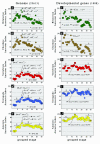The vertebrate phylotypic stage and an early bilaterian-related stage in mouse embryogenesis defined by genomic information
- PMID: 17222327
- PMCID: PMC1797197
- DOI: 10.1186/1741-7007-5-1
The vertebrate phylotypic stage and an early bilaterian-related stage in mouse embryogenesis defined by genomic information
Abstract
Background: Embryos of taxonomically different vertebrates are thought to pass through a stage in which they resemble one another morphologically. This "vertebrate phylotypic stage" may represent the basic vertebrate body plan that was established in the common ancestor of vertebrates. However, much controversy remains about when the phylotypic stage appears, and whether it even exists. To overcome the limitations of studies based on morphological comparison, we explored a comprehensive quantitative method for defining the constrained stage using expressed sequence tag (EST) data, gene ontologies (GO), and available genomes of various animals. If strong developmental constraints occur during the phylotypic stage of vertebrate embryos, then genes conserved among vertebrates would be highly expressed at this stage.
Results: We established a novel method for evaluating the ancestral nature of mouse embryonic stages that does not depend on comparative morphology. The numerical "ancestor index" revealed that the mouse indeed has a highly conserved embryonic period at embryonic day 8.0-8.5, the time of appearance of the pharyngeal arch and somites. During this period, the mouse prominently expresses GO-determined developmental genes shared among vertebrates. Similar analyses revealed the existence of a bilaterian-related period, during which GO-determined developmental genes shared among bilaterians are markedly expressed at the cleavage-to-gastrulation period. The genes associated with the phylotypic stage identified by our method are essential in embryogenesis.
Conclusion: Our results demonstrate that the mid-embryonic stage of the mouse is indeed highly constrained, supporting the existence of the phylotypic stage. Furthermore, this candidate stage is preceded by a putative bilaterian ancestor-related period. These results not only support the developmental hourglass model, but also highlight the hierarchical aspect of embryogenesis proposed by von Baer. Identification of conserved stages and tissues by this method in various animals would be a powerful tool to examine the phylotypic stage hypothesis, and to understand which kinds of developmental events and gene sets are evolutionarily constrained and how they limit the possible variations of animal basic body plans.
Figures


References
-
- von Baer KE. Entwicklungsgeschichte der Thiere: Beobachtung und Reflexion. Königsberg: Bornträger; 1828.
-
- Hall BK. Evolutionary Developmental Biology. 2. Dordrecht, Kluwer Academic Publishers; 1992.
-
- Seidel F. Körpergrundgestalt und Keimstruktur eine Erörterung über die Grundlagen der vergleichenden und experimentellen Embryologie und deren Gültigkeit bei phylogenetischen Überlegungen. Zool Anz. 1960;164:245–305.
-
- Elinson RP. Change in developmental patterns: embryos of amphibians with large eggs. In: Raff RA, Raff EC, editor. Development as an Evolutionary Process. New York: Alan R. Liss; 1987. pp. 1–21.
Publication types
MeSH terms
LinkOut - more resources
Full Text Sources
Other Literature Sources
Research Materials

